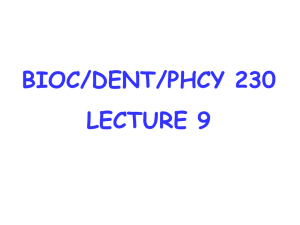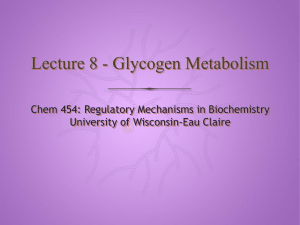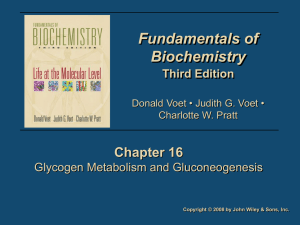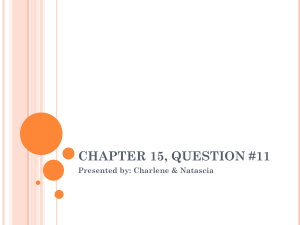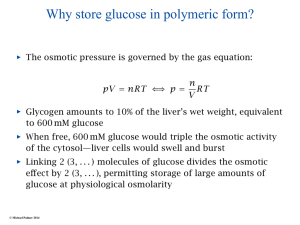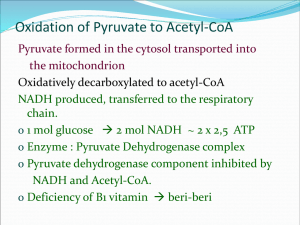Glycogen Metabolism Objectives
advertisement
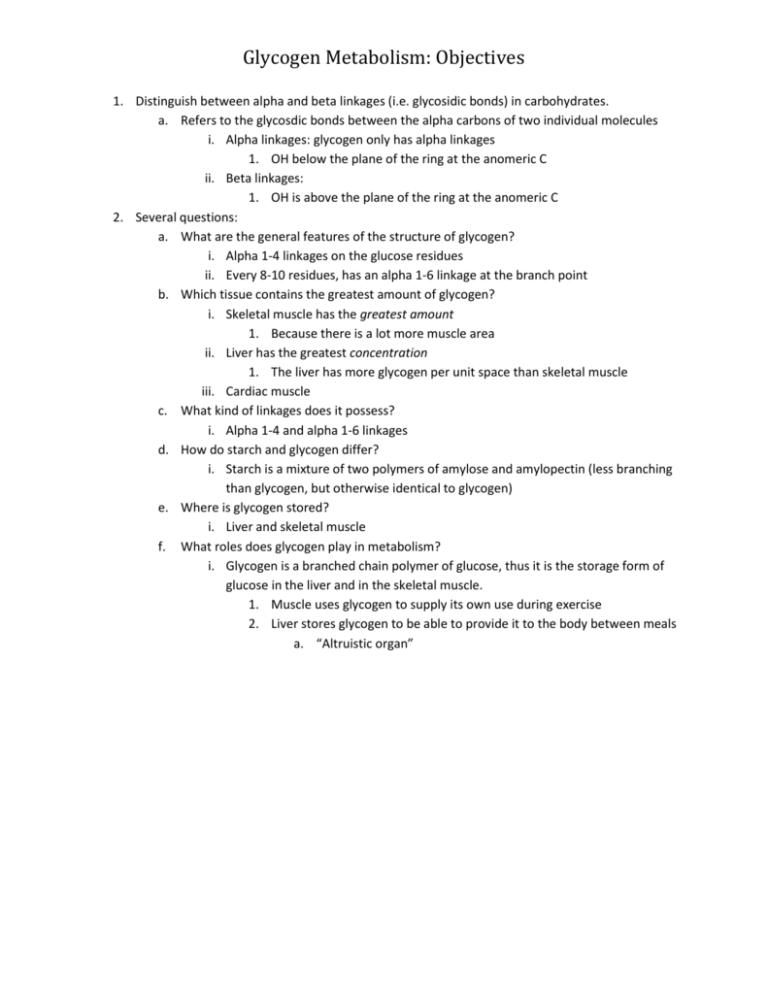
Glycogen Metabolism: Objectives 1. Distinguish between alpha and beta linkages (i.e. glycosidic bonds) in carbohydrates. a. Refers to the glycosdic bonds between the alpha carbons of two individual molecules i. Alpha linkages: glycogen only has alpha linkages 1. OH below the plane of the ring at the anomeric C ii. Beta linkages: 1. OH is above the plane of the ring at the anomeric C 2. Several questions: a. What are the general features of the structure of glycogen? i. Alpha 1-4 linkages on the glucose residues ii. Every 8-10 residues, has an alpha 1-6 linkage at the branch point b. Which tissue contains the greatest amount of glycogen? i. Skeletal muscle has the greatest amount 1. Because there is a lot more muscle area ii. Liver has the greatest concentration 1. The liver has more glycogen per unit space than skeletal muscle iii. Cardiac muscle c. What kind of linkages does it possess? i. Alpha 1-4 and alpha 1-6 linkages d. How do starch and glycogen differ? i. Starch is a mixture of two polymers of amylose and amylopectin (less branching than glycogen, but otherwise identical to glycogen) e. Where is glycogen stored? i. Liver and skeletal muscle f. What roles does glycogen play in metabolism? i. Glycogen is a branched chain polymer of glucose, thus it is the storage form of glucose in the liver and in the skeletal muscle. 1. Muscle uses glycogen to supply its own use during exercise 2. Liver stores glycogen to be able to provide it to the body between meals a. “Altruistic organ” Glycogen Metabolism: Objectives 3. Several questions: a. Describe the general features of the breakdown and synthesis of glycogen (i.e. glycogenolysis and glycogenesis) i. Breakdown (glycogenolysis) 1. Take glycogen, break it down to get a glucose subunit cleaved (at alpha 1-4 linkage), when we will add a phosphate to it (via the enzyme “phosphorylase”) a. Produces: glucose-1-phosphate 2. Cleave off all the little branches, going all the way down until you get to a residue which is 4 away from the a. Debranching enzyme i. Alpha-glucanoglucosal-transferase (transfers 3 residues to the other branch, leaving behind a single residue) ii. Amylo-1,6-glucosidase (will cleave the 3 glucose residues to give one molecule of glucose iii. Produces: a free glucose ii. Synthesis of glycogen (glycogenesis) 1. Begin with glucose (glucokinase or hexokinase) to produce G-6-P a. Or (if in a test tube) need to start out with glycogenin (protein) 2. G-6-P to G-1-P a. Using UDPG + UTP, which eliminates a PPi (pyrophosphate) i. enzyme: UDPG Pyrophosphorylase 1. Regulatory Enzyme 3. Primer (glycogenin + 8 or 10 glucoses) + UDPG primer + glucose +UDP a. Enzyme: glycogen synthase i. Regulatory Enzyme b. Forms alpha (1-4) bonds c. Repeats the glucose addition of the residues onto the primer chain, doing this same process over and over 4. Branching (pg. 88) a. Alpha (1-4) glucose transfers 7 glucoses and forms an alpha (1-6) branch i. Enzyme: Branching Enzyme Glycogen Metabolism: Objectives 4. 5. 6. 7. b. Name the enzymes involved. i. Phosphorylase: (phosphate group makes it ACTIVE) 1. Phosphate comes from ATP by the action of phosphorylase kinase 2. Hydrolyzes (breaks) alpha (1-4) bonds ii. Alpha-glucanoglucosal-transferase: 1. Hydrolyzes (breaks) alpha (1-4) bonds iii. Amylo-1,6-glucosidase: 1. Hydrolyzes (breaks) alpha (1-6) bonds iv. Debranching enzyme: 1. It is a transferase enzyme 2. Transfers residue of glucose C3 from alpha (1-4) to another alpha (1-4) 3. To make an alpha (1-6) branchpoint c. Which glycosidic bonds are hydrolyzed by i. Phosphorylase: ii. Transferase enzyme: iii. Glucosidase: What is the main product resulting from glycogenolysis? a. Glucose-1-Phosphate How is free glucose produced in glycogenolysis? a. In the liver i. G-1-P conversion to G-6-P 1. Gives free glucose, and glucose is transported to extrahepatic tissue ii. b. In muscle i. G-1-P converted to G-6-P ii. Cannot convert G-6-P into free glucose 1. Missing the enzyme necessary for this (glucose-6-phosphatase) 2. Free glucose will not be released into the bloodstream! iii. G-6-P will be used in TCA to produce ATP; uses G-6-P for its own E needs Name the glucose derivative required for the biosynthesis of glycogen. a. UDPG (uridine diphospho glucose) State how UDPG is formed from glucose-6-phosphate. a. Converted to G-1-P with UTP to produce UDPG b. Name the enzymes involved. i. UDPG pyrophosphorylase Glycogen Metabolism: Objectives 8. Several questions: (pg. 89) a. What is the role of phosphorylase in the breakdown of glycogen? Cleaves off the glucose, one at a time, to produce G-1-P i. Key enzyme required to metabolise glycogen into glucose b. How is it: i. “turned on” 1. Phosphorylase is ACTIVE when it is PHOSPHORYLATED. 2. Phosphorylase kinase phosphorylates this a. Uses ATP to phosphorylate ii. “turned off” 1. Phosphorylase is INACTIVE when it is DEphosphorylated. a. Removes the phosphate group with a specific phosphatase to inactivate the phosphorylase i. Phosphatase 1 c. What is the role of phosphorylase kinase in “turning on” phosphorylase? i. It will phosphorylate it, utilizing ATP. d. What is the role of protein phosphatase in “turning off” phosphorylase? i. It will remove the phosphate group and inactivate the phosphorylase 9. Several questions: (pg.89) OPPOSITE of Question #8 a. What is the role of glycogen synthase in the synthesis of glycogen? i. Is inactive when it is phosphorylated (which in inactive due to presence of epinephrine) b. How is it i. “turned on” 1. Insulin 2. Removing phosphate group from synthase (thereby activating it) ii. “turned off” 1. Epinephrine and glucagon 2. Removing phosphate group from the phosphatase c. What role does protein kinase play in turning glycogen synthase off? i. It will phosphorylate it, utilizing ATP, thus turning off synthesis 1. (and turning on –lysis) d. What role does protein phosphatase play in “turning on” glycogen synthase? i. When phosphatase is inactive, glycogen synthase is activated. 1. Cannot breakdown and buildup at same time! Glycogen Metabolism: Objectives 10. Several questions: (pg 96) a. Explain how the synthesis and breakdown of glycogen are coordinated and controlled. i. Hormones 1. Glucagon, Epinephrine, Insulin b. What roles do insulin and glucagon play in the control of liver glycogen? i. Glucagon promotes the breakdown ii. Insulin promotes the synthesis c. What is the role of cyclic AMP in i. Stimulating glycogen breakdown 1. Phosphorylates the phosphoylase to promote breakdown ii. Switching off glycogen synthesis 1. Cannot breakdown and synthesize at the same time!!! 11. How do glucagon and epinephrine stimulate the formation of cyclic AMP? a. Cyclic AMP acts the protein kinase A, which in turn, acts on the phosphorylase kinase to phosphorylate it, which in turn phosphorylates the phosphorylase. b. Distinguish between their effects on muscle and liver glycogen metabolism. i. Glucagon acts ONLY in the liver to help to release glucose from glycogen ii. Epinephrine acts in liver and muscle to help to release glucose from glycogen 12. Name the biochemical defect i.e. the defective enzyme in at least three known glycogen storage diseases. a. Von Gierke’s Disease: Causes an increase in glycogen in the liver and kidney i. Defective enzyme is Glucose-6-Phosphatase b. Anderson’s Disease: Causes a normal amount of glycogen, but has very long outer branches in the liver and spleen i. Defective enzyme is Branching Enzyme c. McArdle’s Disease: Causes a moderately increased amount of glycogen in the muscle, but glycogen maintains normal structure i. Defective enzyme is Phosphorylase
